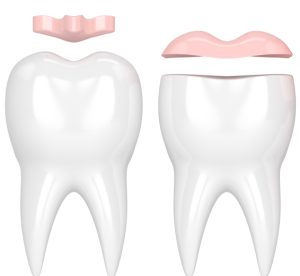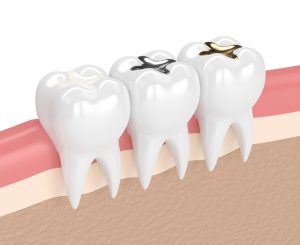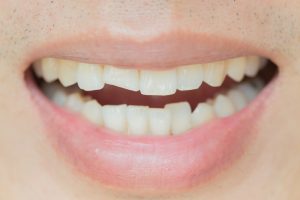Seamlessly Restore Your Smile & Preserve Tooth Structure
Are you tired of unsightly, uncomfortable dental fillings? At Polasek Digital Dentistry & Schaefer Dental Group, Howell, MI, cosmetic dentist, Dr. Kyle Polasek offers an exceptional solution – dental inlays and onlays. Learn how these indirect restorations can transform your smile by calling our Livingston County dental practice at 517-546-8983.
What Are Dental Inlays and Onlays?
Dental inlays and onlays, also known as indirect fillings or partial crowns, are custom-made restorations precisely crafted to fit your unique tooth structure. Unlike traditional fillings, these cosmetic dental restorations are fabricated outside of your mouth and then bonded into place, ensuring a perfect fit and superior durability.
An inlay is used to fill the center of a tooth, while an onlay covers the entire chewing surface, including one or more cusps. These restorations are typically made of durable materials and provide a strong, long-lasting solution that blends seamlessly with your natural teeth.
Materials Used for Dental Inlays and Onlays
Composite Resin
Composite resin inlays and onlays are tooth-colored restorations made of a mixture of plastic and glass particles. Dental onlays and inlays made from composite materials offer excellent aesthetics as they can be closely matched to the natural color of the teeth. While composite resin is durable and can withstand moderate chewing forces, dental onlays and inlays made from this resin may not be as strong as other materials and may require more frequent replacement over time.
Porcelain or Ceramic
Porcelain or ceramic inlays and onlays are highly aesthetic restorations that closely mimic the appearance of natural tooth material. These tooth-colored inlays and onlays are durable, stain-resistant, and biocompatible, making them suitable for use in visible areas of the mouth. Porcelain/ceramic restorations are well-tolerated by gum tissue and are resistant to wear, providing long-lasting results.
Gold Alloy
Gold alloy inlays and onlays are extremely durable and have been used in dentistry for decades. They offer excellent longevity and biocompatibility, making them suitable for patients with metal allergies. While gold restorations are highly resistant to wear and corrosion, their gold color may not be as aesthetically pleasing as tooth-colored materials for visible areas of the mouth.
Zirconia
Zirconia inlays and onlays are known for their strength, durability, and biocompatibility. They are made of a white, tooth-colored material that closely resembles natural tooth enamel. These tooth-colored inlays and onlays are highly resistant to fracture and wear, making them suitable for use in both front and back teeth where chewing forces are greater.
Hybrid Materials (Ceramic Reinforced With Resin)
Hybrid material inlays and onlays combine the strength and durability of ceramics with the flexibility and bonding properties of resin. These restorations offer excellent aesthetics, strength, and durability, making them suitable for a wide range of dental applications. Hybrid materials may be used in both anterior and posterior teeth, providing natural-looking results that can withstand the demands of everyday chewing.
Porcelain Fused to Metal (PFM)
Porcelain fused to metal inlays and onlays combine the strength of a metal substructure with the aesthetic appeal of porcelain. While PFMs offer good strength and durability, they may not be as aesthetic as all-ceramic restorations due to the potential for a metal margin to show through the porcelain. However, PFMs are still commonly used for posterior restorations where strength and longevity are priorities.
Glass Ionomer Cement
Glass ionomer cement inlays and onlays are tooth-colored restorations that bond chemically to the tooth structure. They release fluoride, which helps prevent decay and promote remineralization of the surrounding teeth. While glass ionomer cement restorations may not be as strong or durable as other materials, they are often used in non-load-bearing areas of the mouth or as temporary restorations.
Benefits of Dental Inlays and Onlays
Some of the many advantages of dental inlays and onlays include:
- Improved Strength and Durability: Inlays and onlays are remarkably strong and can last between ten and thirty years with proper care.
- Enhanced Aesthetic Appearance: These restorations are custom-made to blend with your natural teeth, providing a natural-looking, beautiful smile.
- Increased Tooth Preservation: Inlays and onlays require less tooth structure removal compared to a basic filling, preserving the strength of the tooth.
- Reduced Risk of Decay: The tight fit of these restorations helps prevent bacteria and decay from entering the tooth.
- Improved Comfort: Dental inlays and dental onlays are designed to fit your entire tooth perfectly, eliminating the risk of discomfort or sensitivity.
- Versatility: Dental inlays and dental onlays can repair various dental problems, including cavities, fractures, and mild to moderate tooth decay.
- Functionality: Both inlays and onlays restore the functionality of damaged or decayed teeth, allowing for comfortable chewing and biting without compromising aesthetics.
- Easy Maintenance: Inlays and onlays are easy to clean and maintain, promoting good oral hygiene habits and helping to prevent future dental issues.
Who Qualifies for Dental Inlays and Onlays?
Patients in Howell, MI, and the surrounding areas who may benefit from dental inlays and onlays include:
- Those with moderate to severe tooth decay or damage that is too extensive for a traditional filling
- Individuals with large, old, or failing fillings that need to be replaced
- Patients with cracks, chips, or worn-down teeth
- People looking to improve the appearance of their smile
- Those with large cavities or tooth structure loss
- Individuals with a history of dental issues or who grind their teeth
- Patients who want a more durable and long-lasting solution than traditional fillings
The Dental Inlay and Onlay Process
Consultation
During your initial consultation at our Howell dental office, Dr. Polasek will thoroughly examine your teeth and discuss your goals for treatment. He’ll determine if dental inlays or onlays are the best option and provide a detailed plan for your care.
Preparation
If you and Dr. Polasek decide that inlays or onlays are right for you, he’ll gently prepare your tooth by removing any decay or old metal fillings first. Impressions of your teeth will be taken, which are used to create your custom restoration.
Inlay or Onlay Placement
Once your inlay or onlay is ready, it’s time for the inlay or onlay procedure. Dr. Polasek will carefully place it in your tooth. The restoration is then bonded in place, creating a strong, durable, and long-lasting solution.
Dental Inlay and Onlay Aftercare
After your procedure, follow these tips to ensure the longevity of your dental inlay or onlay:
- Brush and floss your teeth regularly to maintain good oral hygiene.
- Avoid hard or sticky foods that could dislodge or damage the restoration.
- Schedule regular dental check-ups and professional cleanings with Dr. Polasek.
- Wear a nightguard if you tend to grind or clench your teeth.
- Be mindful of any changes in the fit or feel of your inlay or onlay and report them to Dr. Polasek promptly.
Frequently Asked Questions
Dental inlays and onlays are highly durable and can last for many years with proper care. On average, these restorations can last 10 to 30 years before needing replacement.
Yes, inlays and onlays are significantly stronger and more durable than traditional fillings. These custom-made restorations are made of high-quality materials that can withstand the daily forces of chewing and biting.
Many dental insurance plans provide coverage for inlays and onlays, though the extent of coverage can vary. Your dental team can help you understand your benefits and explore payment options.
The process typically takes two appointments. During the first visit, your dentist will prepare your tooth and take impressions for the custom restoration. At the second appointment, they will place and bond the inlay or onlay in place.






